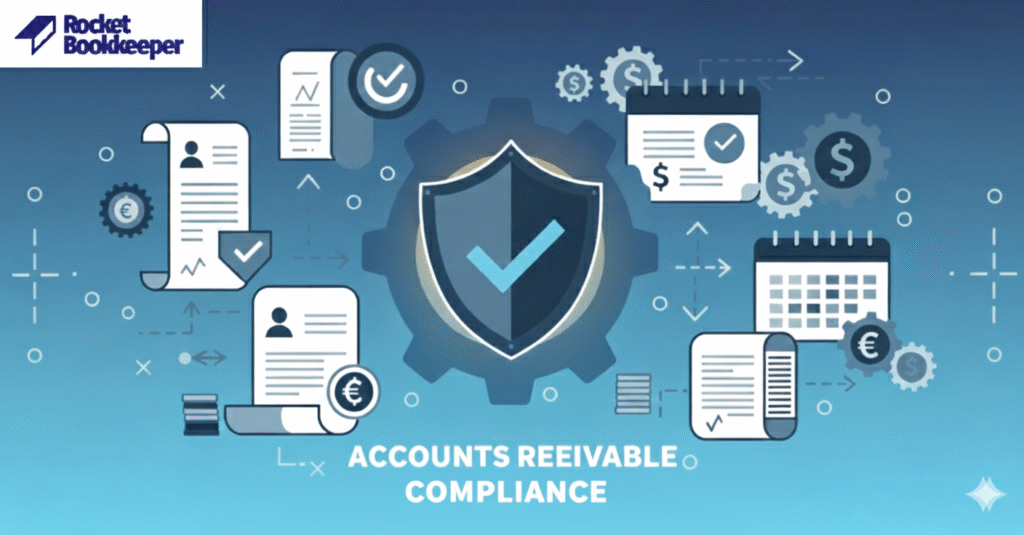Protecting Your Profits, People, and Peace of Mind
At Rocket Bookkeeper, we know that running a business isn’t just about making sales; it’s about making sure your financial engine runs smoothly and safely. That’s where Accounts Receivable (AR) and Accounts Payable (AP) come in—the heartbeat of your cash flow. But along with that heartbeat comes a crucial responsibility: managing compliance and risk.
Think of it this way: Compliance is your business’s seatbelt, and risk management is your defensive driving. Here’s our human-touch guide to navigating the essential safeguards in AR/AP, turning stress points into strengths.
Regulatory Compliance: Keeping the Feds Friendly
Regulatory compliance might sound intimidating, but at its core, it’s about fairness and transparency. This is the foundation for everything else.
- For AR: You must comply with consumer protection laws (like the Fair Debt Collection Practices Act if applicable) to ensure you treat customers ethically and legally when collecting payments.
- For AP: This involves adhering to requirements like those set by the IRS for 1099 reporting, ensuring you properly classify and report payments to contractors.
The Human Touch: Compliance protects your company’s reputation. A single violation can cost you not just fines, but the trust of your customers and vendors.
Managing Bad Debts & Write-Offs: The Cost of Doing Business
Not every invoice will be paid, and accepting that is key to healthy finance. Bad debt is a risk that needs proactive management, not just reactive accounting.
- Be Proactive: Establish clear credit policies before extending credit.
- Be Consistent: Follow a standardized process for identifying, escalating, and ultimately writing off debt. This process should be clearly documented and adhered to.
The Human Touch: Write-offs shouldn’t be seen as a failure, but as a realistic adjustment. By recognizing the loss promptly, you ensure your financial statements are accurate, allowing you to make better, informed decisions about your future clients.
Internal Controls: Your First Line of Defense
Internal controls are the checks and balances designed to prevent errors, fraud, and misstatements. This is the most crucial step in protecting your bottom line from internal threats.
- Segregation of Duties (SoD): The golden rule! No single person should be able to process a transaction from start to finish. For example, the person who approves a payment shouldn’t be the same one who initiates the payment.
- Authorization Limits: Set clear spending limits for different team members in AP.
The Human Touch: Good controls aren’t about mistrust; they’re about protecting your team. They prevent someone from being put in a compromising position and ensure that accidental errors are caught before they become expensive problems.
AR/AP Documentation Best Practices: Your Paper Trail
If it wasn’t documented, it didn’t happen. Clear, organized documentation is the bedrock of compliance and the key to surviving any audit.
- Ensure every invoice, payment, and credit memo is attached to supporting documentation (POs, receipts, contracts).
- Implement a standardized naming and storage convention, whether digital or physical.
Audit Readiness: Making the Auditor’s Job Easy
An audit is simply a review to ensure your books match reality. If your documentation and internal controls are strong, you’ll be ready.
- Regular Reconciliation: Reconcile your AR and AP ledgers to the general ledger monthly.
- Clear Policies: Have your policies (credit, collections, payment) written down and accessible.
Data Security: Guarding Customer & Vendor Info
In AR/AP, you handle sensitive data: bank details, social security numbers (for 1099s), and confidential pricing. Protecting this data is a non-negotiable risk.
- Secure Storage: Use encrypted, secure systems for storage.
- Access Control: Limit who on your team can access sensitive vendor or customer banking information.
Compliance with Tax Rules: Getting the Numbers Right
Incorrect tax withholding or reporting can lead to serious penalties.
- Sales Tax (AR): Ensure you charge and remit the correct sales tax based on the customer’s location.
- 1099s/W-9s (AP): Diligently collect W-9 forms from all independent contractors before paying them to ensure accurate year-end 1099 filing.
Vendor Credit Risk in AP: Protecting Your Supply Chain
While AR deals with customer credit risk, AP has a flip side: vendor credit risk. This is the risk that a crucial vendor or supplier might go out of business.
- Diversification: Have backup vendors for mission-critical supplies.
- Monitor: Watch for signs of financial distress in key suppliers (e.g., changes in delivery, requests for unusual payment terms).
Escalation Policies for Collections: Clear Steps, Clear Boundaries
A collection policy defines when and how you follow up on overdue payments.
- Standardize: Move from friendly reminders to firmer notices and, finally, to formal collection action on a consistent, predefined schedule.
- Be Empathetic: Remember the human behind the late payment. A clear process allows you to be firm but fair.
Technology Risk: When Your System Fails You
Today, AR/AP relies heavily on software. Technology risk is the chance that your system could fail, be hacked, or lose data.
- Robust Backups: Ensure your financial data is backed up daily and restorable.
- Software Updates: Keep your bookkeeping software (like QuickBooks or your ERP) patched and updated to address security vulnerabilities.
The Rocket Bookkeeper Takeaway
Managing compliance and risk in AR/AP is not a burden; it’s a smart investment. It protects your cash flow, secures your company’s future, and allows your team to operate with confidence and integrity. With solid internal controls and a human-centered approach, you’ll keep your financial engine running at “rocket speed,” safely and successfully!


